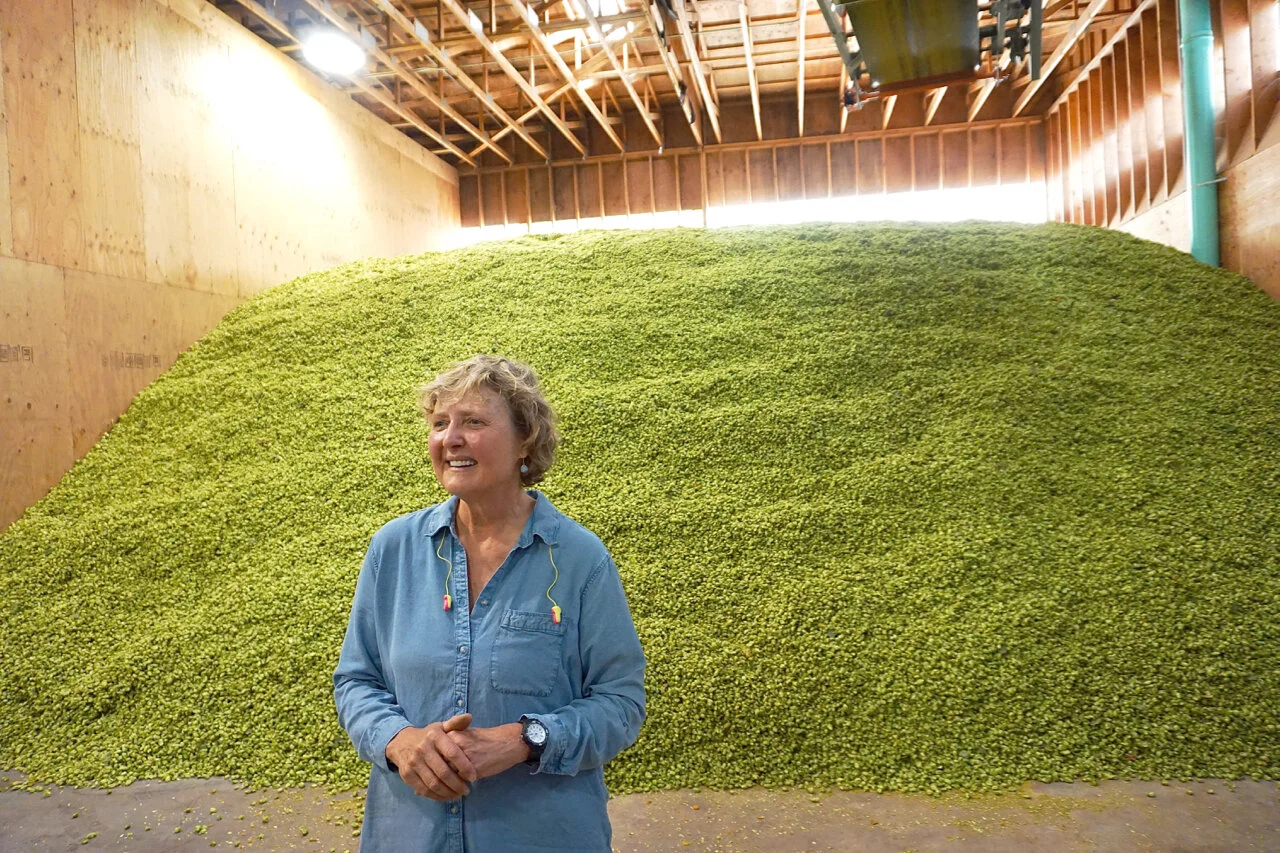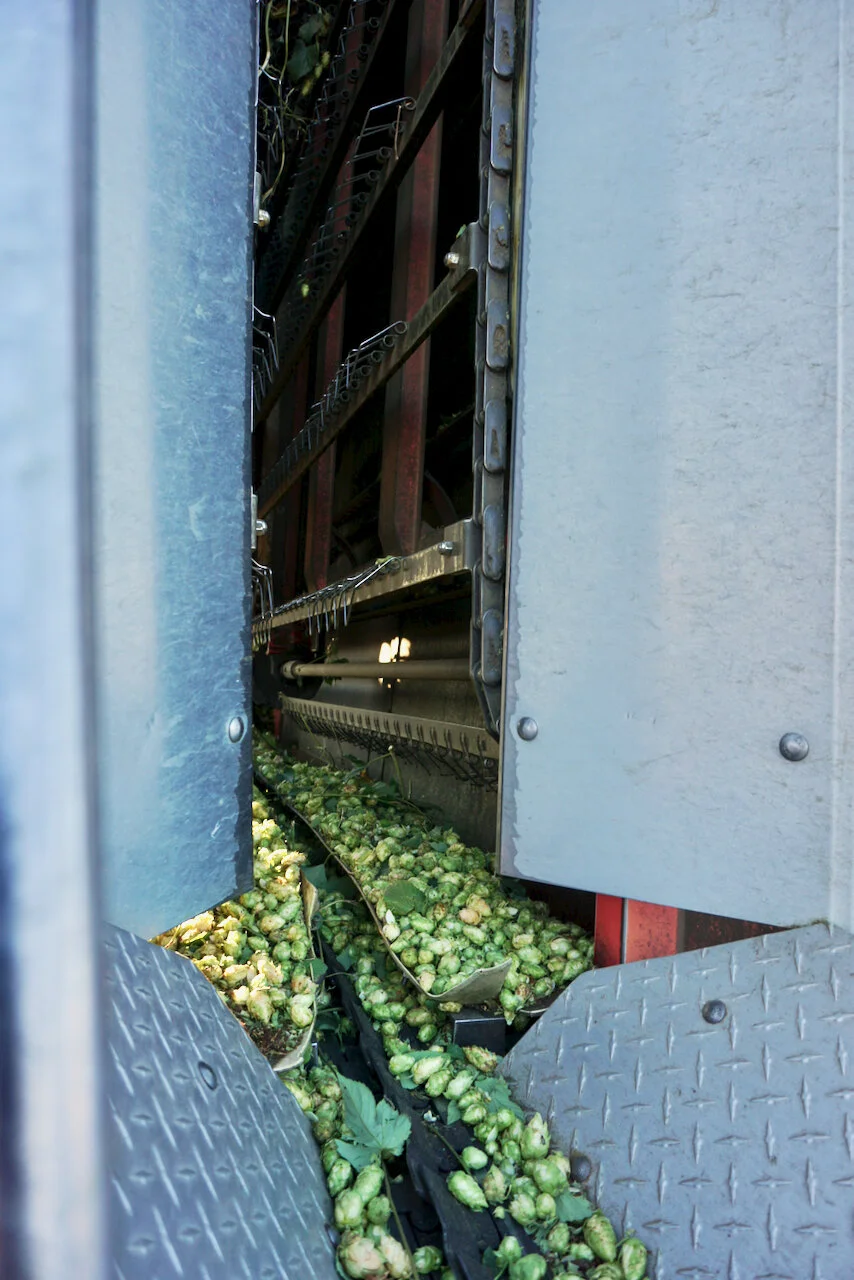Fresh Hop Season looks different during Pandemic
hop picker crew stripping bines in Yakima, Washington © New School Beer
Nearly six months into a worldwide pandemic that has radically disrupted life, most of us are trying to cling to a sense of normalcy. This includes the craft beer industry, which has been adapting and even innovating in a time when one of the biggest sources of revenue for many breweries – their taprooms - is either shut down or functioning at drastically reduced capacity. This reality brings us to a question: what does this year’s fresh hop season look like for those who grow and process hops, those who brew with them, and those who consume the resulting beers? And also, will the craft beer industry be able to maintain any of the precious normalcy for this year’s fresh hop season?
hops ready for harvest in Yakima © New School Beer
Fresh hop season in the Pacific Northwest is typically a joyous celebration and is truly unique to the region since nearly all U.S. hops are grown here. The proximity to hop growers in the Yakima and the Willamette Valley – two of the largest growing regions - gives Pacific Northwest brewers an advantage in being able to source fresh hops and get them into beers within a small window of time. Any other brewery in the country must source their hops locally or have them shipped overnight, which isn’t exactly cheap and feels like more of a novelty in that it lacks a local touch. Most fresh hop beers are also offered as draft only, due partly to smaller batches and to the fact that the beers are at their best when enjoyed fresh within 2-4 weeks of being released.
For hop producers, this year presents a whole new set of challenges while exacerbating existing ones. Finding enough labor to work harvest has always been tough, and more so in recent years due to Trump’s inhumane immigration policies that have scared the shit out of farmworkers and made the highly bureaucratic H2A work visa program even more difficult to navigate, especially for smaller growers and farms. And now there is the challenge of also maintaining a work environment that, besides being physically safe, will also prevent the spread of COVID-19. In the Yakima Valley, the country’s major hop-growing region, this last part is particularly acute as the area recently saw a large spike in cases, some of which are related to agricultural workplaces. Adding to the hurdles that growers face, there is also Mother Nature and the risk of a smaller crop.
Kevin Quinn, co-owner and sales manager at Yakima’s Bale Breaker Brewing Company, which is also a family-run hop farm, says that the “spring of 2020 was unusual to say the least for all kinds of obvious reasons, but that also extended to the weather here in the Yakima Valley. [The] reversal of precipitation patterns [in the spring] got the crop off to a slower start than usual.” On top of the weather, she points to “measures taken in the spring to reduce yields as a response to the anticipated slowdown in beer production due to the COVID-19 pandemic.” All of this equates to a major dent in the livelihoods of growers, brewers and farmworkers.
hop dog at Perrault Hop Farm, a member of Yakima Chief Hops © New School Beer
At Yakima Chief Hops, which supplies hops to many breweries around the world, “growers acted quickly to adjust and reduce acreage for the 2020 growing season,” according to Public Relations and Corporate Communications Manager Cait Schut, who points out that “the goal was to offset a potential oversupply from brewers needing less pounds and possible contract adjustments due to the temporary closure of their breweries. With that said, this will result in some empty fields and overall reduced volume intake for [Yakima Chief]. However, this is positive news as our ultimate goal is to maintain a healthy supply chain for the benefit of both our growers and brewers, and we are grateful that we had time to react accordingly before the growing season started.”
hops run through a picker on the fields in Yakima © New School Beer
Luckily, Yakima Chief “facilities and farms are still operating as ‘normal’ with the exception of adhering to local and CDC guidelines,” says Schut, adding that “All [Yakima Chief] farms and facilities have maintained an overall healthy environment with no outbreaks.” Like Kevin Quinn at Bale Breaker, Schut mentions that the “overall crop looks to be average, with some varieties coming in at slightly below average,” but that this will not affect supply for fresh hops or otherwise.
In Oregon’s Willamette Valley, hop growers are facing a stronger crop but this season is not without its challenges.
Gayle Goschie in front of a mountain of freshly kilned hops © New School Beer
“This year’s crop looks very strong. We all (plants included) enjoyed a cooler spring and early summer which Oregon aroma hops responded well to,” says Brian Bolduc, Assistant Director of Business and Sales at Goschie Farms, Inc. in Silverton. He also points to the benefit of farms to be able to enact social distancing measures with a little more ease. “Fortunately for farms like ours, we have had ample space to keep distanced and the number of shared items/spaces low. That becomes more difficult but also more important as we begin harvest with additional employees added, however I’m confident that we have a solid plan in place to keep our employees as healthy as possible.”
As for fresh hops, Bolduc says Goschie is moving ahead but that they have “made some adjustments to the procedure in which brewers pick up their hops at the farm in order to minimize their exposure to our employees and indoor processing areas.” That said, even though they are “set up to provide just as many fresh hops to brewers as previous years,” Bolduc says he expects there to be fewer fresh hop beers made this year. “This is an incredibly challenging time for breweries, and fresh hop beers require extra time, money, and resources to make. There may be many breweries that are simply unable to make it work this year, which is all the more reason to continue supporting them.”
Unfortunately, it also seems likely that there will be less out of state breweries visiting for the annual hop selection process. This has led hop producers to adapt and innovate by expanding offerings such as sample mailing.
https://youtu.be/nzqF9kPmLvU
“Visits to the farm from our customers locally and globally will be reduced significantly this year due to the impacts of COVID,” says Blake Crosby, President and CEO of Crosby Hops in Woodburn. “This time of year is traditionally coveted by hop growers and merchants because brewers make the annual pilgrimage to the Pacific Northwest to select their hops for the year and also develop deeper relationships with growers, suppliers and their industry peers. The majority of the hop selections we're providing this year will be remote by way of sending leaf hop samples directly to breweries for immediate selection. It definitely isn't the idyllic and ceremonial hop selection experience brewers have come to love but it still gives our customers the opportunity to select quality hops from world-class growers.”
Other producers are also moving rapidly ahead on virtual and “remote” hop selection via Zoom, which takes some of the magic out of the process but still keeps the industry moving. Sadly, this takes away the fun of fresh hop season for both the producers and brewers, who often congregate to tour hop fields and share beers.
Loftus Hop Farms owner Mike Smith and his daughter Meghan Quinn of Bale Breaker Brewing
“Harvest is usually the busiest time of year for the Yakima Valley and we are definitely going to miss hosting our extended family from all corners of the world,” says Bale Breaker’s Quinn.
Luckily, Northwest brewers are still able to come and get their fresh hops even if they can’t stick around. Hop producers in both the Yakima and Willamette Valley have adjusted to the current moment much like other businesses, offering contactless pick-up with minimal interaction.
“Several of our hop farming partners have reached out to us this year to inform us of extra precautions they are taking to ensure the safety of their workers as well as to safeguard customers. Several farms have asked us not to bring more than two employees to the farm for picking up fresh hops and are also asking any representatives of our brewery to wear PPE such as face masks,” says Ryan Buxton, Head Brewer at Portland’s Ex Novo Brewing Co. “Our brief visits will be straight to the point in order to keep everyone as safe as possible.”
Some breweries, such as Hood River’s pFriem, have decided to forego fresh hop beers altogether due to decreased demand from bars as well as in their own taproom, but others are determined to push forward with their fresh hop beers even if it means things might look a little different. The silver lining for beer drinkers is that we can expect more canned offerings.
At Portland’s Breakside Brewery, Brewmaster Ben Edmunds says they are “planning on brewing and releasing the same amount of fresh hop beer that we have in the past.” He adds that “this is the first year that we are going to put some of our fresh hop beer in package. We'll be canning four different fresh hop beers during this year's harvest. In the past, I've hesitated to bottle or can fresh hop beer because of how volatile it is, but in this current environment, we determined that packaging some fresh hop beer was the best way to get these types of beers to consumers given the altered draft market.”
At Ex Novo Brewing Co., Ryan Buxton says they are “moving ahead this year with our fresh hop plans, making more this year than we ever have previously” before adding that most of it will be packaged. “Our current plan is to produce four batches, equaling 150 bbl. total of fresh hop beer, utilizing three different hop varieties… We are shifting a larger percentage of these beers into package as on-site consumption is down for health and safety reasons. This year we will only have one batch that is draft only.”
Bale Breaker previously only canned one fresh hop beer, but this year they are adapting. “We installed a labeler last month so we now have the ability to can and label smaller runs. This labeler will allow us to can more wet hop beers this year to help ease the blow in draft sales,” says Quinn.
hops run through a sorter in Yakima
Seattle’s Fremont Brewing has typically rolled out a large amount of canned fresh hop beers and, according to Owner Sara Nelson, this year will be no different. Beer drinkers can expect the brewery’s usual and highly coveted Cowiche Canyon Fresh Hop Ale and Field to Ferment series, as well as Head Full of Fresh Hops fresh hops hazy IPA brewed with Mosaic and HBC 696 hops.
Level Beer Fresh-Hopped Hazy IPA
Level Beer Fresh-Hopped Hazy IPA
Shane Watterson, Brewer and Owner at Portland’s Level Beer, expects that the “draft game certainly [will] be different this year. In the past we have brewed hundreds of barrels of fresh hop beer, mostly because it sells so quickly in draft (and because we love it), but this year so many places aren't open, or are operating with minimal capacity, that we will certainly have less draft-only versions of fresh hop beers than in past years.” He reassuringly adds that the brewery will still be offering up three canned fresh hop beers.
Ex Novo Fresh Hop IPA
More breweries doing packaged beer leads to its own set of logistical challenges. “We do not own our own canning line here in Portland,” says Ex Novo’s Buxton. “We are at the mercy of preemptively scheduling canning runs through mobile packaging companies like Craft Canning; using our crystal ball in hopes that we get dates correct. We are given estimated windows of harvest by hop farms about a month to six weeks in advance, but these are constantly moving targets. Weather forecasts change and with them so does the window of opportunity for harvest. It is quite challenging every year to get the stars to align where we can have beer and fresh hops ready at the same time, while also having a date scheduled just at the right time for canning; a lot of moving parts where one wrench in the gears can adversely impact our production schedules.”
While this year’s fresh hop season certainly looks different and there will likely be less overall fresh hop beer due to decreased draft opportunities, beer drinkers around the Northwest can take comfort knowing that many of their favorite breweries are pushing ahead. Most of us would kill to be able to pull up a seat at our favorite beer bar for a pint or to attend one of the numerous fresh hop festivals that take place each year, but at least we will still have the ability to savor one of the best parts of being a beer lover in the Pacific Northwest. This is a testament to the dedication and passion of the Northwest craft beer industry.
freshly harvested hop fields at Crosby Hop Farm












